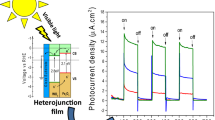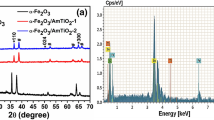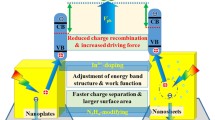Abstract
A heterojunction photoanode of Fe2O3 loaded on a WO3 film on a fluorine-doped tin oxide substrate (FTO-WO3/Fe2O3) was prepared via a simple hydrothermal and chemical vapor deposition (CVD) growth method. The photoanode showed higher photoelectrochemical (PEC) water-splitting activity than that of the pristine FTO-WO3 under simulated sunlight because of the synergistic effect of Fe2O3 and WO3. The as-synthesized material was characterized by X-ray diffraction (XRD), scanning electron microscopy (SEM), transmission electron microscopy (TEM), and X-ray photoelectron spectroscopy (XPS). The photocurrent density was estimated by linear sweep voltammetry and further confirmed using intensity-modulated photocurrent spectra. Experiments demonstrated that the coated Fe2O3 enhanced the separation and migration efficiencies of the photoinduced electrons and holes, improving the PEC water-splitting properties. The FTO-WO3/Fe2O3 photoanode showed a 1.25 times enhancement in photocurrent density compared with FTO-WO3. This result suggests that facile chemical vapor deposition growth is an effective way to fabricate heterojunctions and improve the properties of WO3 photoanodes for PEC water-splitting applications.








Similar content being viewed by others
References
Choi J, Song T, Kwon J, Lee S, Han H, Roy N, Terashima C, Fujishima A, Paik U, Pitchaimuthu S. WO3 nanofibrous backbone scaffolds for enhanced optical absorbance and charge transport in metal oxide (Fe2O3, BiVO4) semiconductor photoanodes towards solar fuel generation. Appl Surf Sci. 2018;447(31):331.
Zhu T, Chong MN, Chan ES. Nanostructured tungsten trioxide thin films synthesized for photoelectrocatalytic water oxidation: a review. Chemsuschem. 2014;7(11):2974.
Yuan K, Cao Q, Li X, Chen H, Deng Y, Wang Y, Luo W, Lu H, Zhang D. Synthesis of WO3@ZnWO4@ZnO–ZnO hierarchical nanocactus arrays for efficient photoelectrochemical water splitting. Nano Energy. 2017;41:543.
Xu S, Fu D, Song K, Wang L, Yang Z, Yang W, Hou H. One-dimensional WO3/BiVO4 heterojunction photoanodes for efficient photoelectrochemical water splitting. Chem Eng J. 2018;349(1):368.
Zeng Q, Li J, Li L, Bai J, Xia L, Zhou B. Synthesis of WO3/BiVO4 photoanode using a reaction of bismuth nitrate with peroxovanadate on WO3 film for efficient photoelectrocatalytic water splitting and organic pollutant degradation. Appl Catal B. 2017;217(15):21.
Hameed A, Gondal MA, Yamani ZH. Effect of transition metal doping on photocatalytic activity of WO3 for water splitting under laser illumination: role of 3d-orbitals. Catal Commun. 2004;5(11):715.
Li W, Li J, Wang X, Chen Q. Preparation and water-splitting photocatalytic behavior of S-doped WO3. Appl Surf Sci. 2012;263(15):157.
Wang C, Zhang X, Yuan B, Wang Y, Sun P, Wang D, Wei Y, Liu Y. Multi-heterojunction photocatalysts based on WO3 nanorods: structural design and optimization for enhanced photocatalytic activity under visible light. Chem Eng J. 2014;237(1):29.
Rahimnejad S, He JH, Pan F, Lee X, Chen W, Wu K, Xu G. Enhancement of the photocatalytic efficiency of WO3 nanoparticles via hydrogen plasma treatment. Mater Res Express. 2014;1(4):045044.
Su J, Guo L, Bao N, Grimes C. Nanostructured WO3/BiVO4 heterojunction films for efficient photoelectrochemical water splitting. Nano Lett. 2011;11(5):1928.
Cao J, Luo B, Lin H, Xu B, Chen S. Thermodecomposition synthesis of WO3/H2WO4 heterostructures with enhanced visible light photocatalytic properties. Appl Catal B. 2012;111(12):288.
Shamaila S, Sajjad AKL, Chen F, Zhang J. WO3/BiOCl, a novel heterojunction as visible light photocatalyst. J Colloid Interface Sci. 2011;356(2):465.
Liu Y, Wygant BR, Kawashima K, Mabayoje O, Hong T, Lee S, Lin J, Kim J, Yubuta K, Li W, Li J, Mullins C. Facet effect on the photoelectrochemical performance of a WO3/BiVO4 heterojunction photoanode. Appl Catal B. 2019;245(15):227.
Liu Y, Wygant BR, Mabayoje O, Lin J, Kawashima K, Kim J, Li W, Li J, Mullins C. Interface engineering and its effect on WO3-based photoanode and tandem cell. ACS Appl Mater Inter. 2018;10(15):12639.
Faraji M, Yousefi M, Yousefzadeh S, Zirak M, Naseri N, Jeon T, Choi W, Moshfegh A. Two-dimensional materials in semiconductor photoelectrocatalytic systems for water splitting. Energy Environ Sci. 2019;12(1):59.
Etacheri V, Di Valentin C, Schneider J, Bahnemann D, Pillai S. Visible-light activation of TiO2 photocatalysts: advances in theory and experiments. J Photochem Photobiol C. 2015;25:1.
Haussener S, Xiang C, Spurgeon JM, Ardo S, Lewis N, Weber A. Modeling, simulation, and design criteria for photoelectrochemical water-splitting systems. Energy Environ Sci. 2012;5(12):9922.
Park HG, Holt JK. Recent advances in nanoelectrode architecture for photochemical hydrogen production. Energy Environ Sci. 2010;3(8):1028.
Qorbani M, Naseri N, Moradlou O, Azimirad R, Moshfegh A. How CdS nanoparticles can influence TiO2 nanotube arrays in solar energy applications? Appl Catal B. 2015;162:210.
Shinde PS, Annamalai A, Kim JH, Choi SH, Lee JS, Jang J. Exploiting the dynamic Sn diffusion from deformation of FTO to boost the photocurrent performance of hematite photoanodes. Sol Energy Mater Sol Cells. 2015;141:71.
Zhan F, Yang Y, Liu W, Wang K, Li W, Li J. Facile synthesis of FeOOH quantum dots modified ZnO nanorods films via a metal-solating process. ACS Sustain Chem Eng. 2018;6(6):7789.
Senthil RA, Priya A, Theerthagiri J, Selvi A, Nithyadharseni P, Madhavan J. Facile synthesis of α-Fe2O3/WO3 composite with an enhanced photocatalytic and photo-electrochemical performance. Ionics. 2018;24:3673.
Yu CL, Chen JC, Zhou WQ, Wei LF, Fan Q. Grinding calcination preparation of WO3/BiOCl heterostructures with enhanced visible light photocatalytic activity. Mater Res Innov. 2015;19(1):54.
Katsumata K, Motoyoshi R, Matsushita N, Okada K. Preparation of graphitic carbon nitride (g-C3N4)/WO3 composites and enhanced visible-light-driven photodegradation of acetaldehyde gas. J Hazard Mater. 2013;260(15):475.
Mirzaei A, Janghorban K, Hashemi B, Bonyani M, Leonardi SG, Neri G. Highly stable and selective ethanol sensor based on α-Fe2O3 nanoparticles prepared by Pechini sol–gel method. Ceram Int. 2016;42(5):6136.
Mirzaei A, Janghorban K, Hashemi B, Bonavita A, Bonyani M, Leonardi SG, Neri G. Synthesis, characterization and gas sensing properties of Ag@α-Fe2O3 core–shell nanocomposites. Nanomaterials. 2015;5(2):737.
Xue D, Zong F, Zhang J, Lin X, Li Q. Synthesis of Fe2O3/WO3 nanocomposites with enhanced sensing performance to acetone. Chem Phys Lett. 2019;716:61.
Bai S, Yang X, Liu C, Xiang X, Luo R, He J, Chen A. An integrating photoanode of WO3/Fe2O3 heterojunction decorated with NiFe-LDH to improve PEC water splitting efficiency. ACS Sustain Chem Eng. 2018;6(10):12906.
Wang S, Chen H, Gao G, Butburee T, Lyu M, Thaweesak S, Yun J, Du A, Liu G, Wang L. Synergistic crystal facet engineering and structural control of WO3 films exhibiting unprecedented photoelectrochemical performance. Nano Energy. 2016;24:94.
Ma XH, Feng XY, Song C, Zou BK, Ding CX, Yu Y, Chen CH. Facile synthesis of flower-like and yarn-like α-Fe2O3 spherical clusters as anode materials for lithium-ion batteries. Electrochim Acta. 2013;93(30):131.
Chen Y, Gao N, Jiang J. Surface matters: enhanced bactericidal property of core–shell Ag–Fe2O3 nanostructures to their heteromer counterparts from one-pot synthesis. Small. 2013;9(19):3242.
Rao PM, Zheng X. Unique magnetic properties of single crystal γ-Fe2O3 nanowires synthesized by flame vapor deposition. Nano Lett. 2011;11(6):2390.
Lee CW, Kim SG, Lee JS. Synthesis of metal oxide hollow nanoparticles by chemical vapor condensation process. Key Eng Mater. 2006;317:219.
Lv F, Fu L, Giannelis EP, Qi G. Preparation of γ-Fe2O3/SiO2-capsule composites capable of using as drug delivery and magnetic targeting system from hydrophobic iron acetylacetonate and hydrophilic SiO2-capsule. Solid State Sci. 2014;34:49.
Suber L, Imperatori P, Ausanio G, Fabbri F, Hofmeister H. Synthesis, morphology, and magnetic characterization of iron oxide nanowires and nanotubes. J Phys Chem B. 2005;109(15):7103.
Yin Z, Bu Y, Ren J, Chen S, Zhao D, Zou Y, Shen S, Yang D. Triggering superior sodium ion adsorption on (200) facet of mesoporous WO3 nanosheet arrays for enhanced supercapacitance. Chem Eng J. 2018;345(1):165.
Zhen C, Wu T, Kadi MW, Ismail L, Liu G, Cheng HM. Design and construction of a film of mesoporous single-crystal rutile TiO2 rod arrays for photoelectrochemical water oxidation. Chin J Catal. 2015;36(12):2171.
Tamilselvan A, Balakumar S, Sakar M, Nayek C, Murugavel P, Kumar KS. Role of oxygen vacancy and Fe–O–Fe bond angle in compositional, magnetic, and dielectric relaxation on Eu-substituted BiFeO3 nanoparticles. Dalton Trans. 2014;43(15):5731.
Kim JH, Jang YJ, Kim JH, Jang JK, Choi SH, Lee JS. Defective ZnFe2O4 nanorods with oxygen vacancy for photoelectrochemical water splitting. Nanoscale. 2015;7(45):19144.
Wang G, Ling Y, Wang H, Yang X, Wang C, Zhang JZ, Li Y. Hydrogen-treated WO3 nanoflakes show enhanced photostability. Energy Environ Sci. 2012;5(3):6180.
Hou Y, Zuo F, Dagg AP, Liu J, Feng P. Branched WO3 nanosheet array with layered C3N4 heterojunctions and CoOx nanoparticles as a flexible photoanode for efficient photoelectrochemical water oxidation. Adv Mater. 2014;26(29):5043.
Jin J, Yu J, Guo D, Cui C, Ho W. A hierarchical Z-scheme CdS-WO3 photocatalyst with enhanced CO2 reduction activity. Small. 2015;11(39):5262.
Wang CW, Yang S, Fang WQ, Liu P, Zhao H, Yang HG. Engineered hematite mesoporous single crystals drive drastic enhancement in solar water splitting. Nano Lett. 2015;16(1):427.
Guo X, Wang L, Tan Y. Hematite nanorods Co-doped with Ru cations with different valence states as high performance photoanodes for water splitting. Nano Energy. 2015;16:320.
Tilley SD, Cornuz M, Sivula K, Grätzel M. Light-induced water splitting with hematite: improved nanostructure and iridium oxide catalysis. Angew Chem Int Ed. 2010;49(36):6405.
Hou Y, Zuo F, Dagg A, Feng P. Visible light-driven α-Fe2O3 nanorod/graphene/BiV1–xMoxO4 core/shell heterojunction array for efficient photoelectrochemical water splitting. Nano Lett. 2012;12(12):6464.
Steinmiller EMP, Choi KS. Photochemical deposition of cobalt-based oxygen evolving catalyst on a semiconductor photoanode for solar oxygen production. Proc Natl Acad Sci USA. 2009;106(49):20633.
Dai G, Yu J, Liu G. Synthesis and enhanced visible-light photoelectrocatalytic activity of p–n junction BiOI/TiO2 nanotube arrays. J Phys Chem C. 2011;115(15):7339.
Yu J, Liao B, Zhang X. Fabrication of 3D ZnO/CuO nanotrees and investigation of their photoelectrochemical properties. Chin J Rare Met. 2018;42(5):449.
Wang B, Tian W. Tellurium-based alloy used as evaporator source for solar-blind photocathode. Chin J Rare Met. 2018;42(5):503.
Cheng Z, Wang W, Yang L, Xu Z, Ji Z, Huang S. Preparation of La–TiO2 and photocatalytic degradation of petrochemical secondary effluent. Chin J Rare Met. 2018;42(9):950.
Acknowledgements
This work was financially supported by the National Natural Science Foundation of China (Nos. 51672143 and 51808303), Shandong Province Natural Science Foundation (ZR2019BEE027, ZR2017MEM018, ZR2018BEM002), Taishan Scholars Program of Shandong Province, Outstanding Youth of Natural Science in Shandong Province (JQ201713) and Australian Research Council Discovery Project (No. 170103317).
Author information
Authors and Affiliations
Corresponding authors
Rights and permissions
About this article
Cite this article
Zhang, YF., Zhu, YK., Lv, CX. et al. Enhanced visible-light photoelectrochemical performance via chemical vapor deposition of Fe2O3 on a WO3 film to form a heterojunction. Rare Met. 39, 841–849 (2020). https://doi.org/10.1007/s12598-019-01311-5
Received:
Revised:
Accepted:
Published:
Issue Date:
DOI: https://doi.org/10.1007/s12598-019-01311-5




